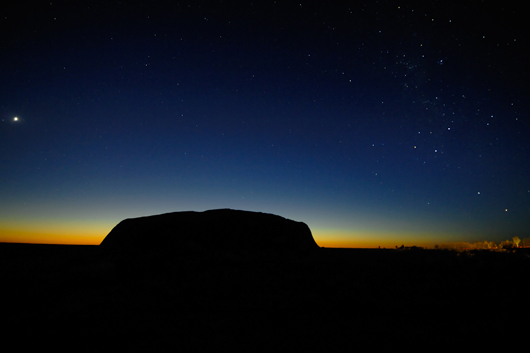A.bc
In Australia, sulle tracce di Chatwin 20 anni dopo Le Vie dei Canti
Palazzo delle Esposizioni, Roma
A.bc
In Australia, in Chatwin's footsteps 20 years after The Songlines Palazzo
Delle Esposizioni, Rome


Il
sole che sorge lascia ancora intravedere le ultime stelle della notte.
La Croce del Sud è bassa, quasi sull’orizzonte, sul lato
del monolite vicino alla strada che inizia a essere rischiarata dalle
luci delle auto e dei bus carichi di turisti che vengono ad assistere
allo spettacolo dell’alba. Venere brilla solitaria sul lato opposto.
Il totem è lì da milioni di anni. Punta di un iceberg di
arenaria alto 348 metri sulla pianura circostante, profondo il doppio
della sua altezza sotto la sabbia. Luogo sacro agli aborigeni, sacralizzato
da visitatori occidentali e orientali da quando dagli anni ‘40 è
cominciato il grande affare del turismo. Uluru o Ayer’s Rock (come
lo battezzò nel 1873 William Gosse, primo bianco a “scoprirlo”)
continua ad attrarre magneticamente. Mezzo milione di persone arrivano
ogni anno per vederlo, toccarlo, scalarlo. Anche Chatwin. Nel 1985 (l’anno
della restituzione di Uluru ai legittimi proprietari tradizionali, gli
Anangu). Lui e Salman Rushdie, entrambi invitati dal festival di letteratura
di Adelaide, come due turisti qualsiasi vanno in macchina verso la grande
roccia. Chatwin la scala, vantandosi di aver battuto degli svizzeri nell’andare
su e giù (Rushdie nega). Gli Anangu invitano a non salire sulla
roccia. Il cammino è lo stesso percorso dall’antenato Mala
al suo arrivo qui nell’epoca della creazione. Ma molti intraprendono
la salita. Agevole ma impegnativa quando fa caldo e tira vento (malgrado
venga chiusa in condizioni climatiche critiche, si registrano diverse
morti l’anno). Alcuni vanno su attrezzatissimi; altri, in short
e sandali. La maggioranza sembra giapponese, molti con guanti e mascherine.
Una connazionale, hostess di un bus, li aspetta alla base e offre di fare
una foto ricordo. Tutti accettano. Posa, scatto e via verso il trofeo
da riportare a casa
The
rising sun still makes the last stars of the night visible. The Southern
Cross is low, almost on the horizon, on the side of the monolith next
to the road that starts to be lit up by the lights of the cars and buses
full of tourists who come to watch the spectacle of the dawn. Venus shines
lonely on the opposite side. The totem has been there for millions of
years. The Peak of a sandstone iceberg 348 meters high on the surrounding
plains, deep twice his height under the sand. Place sacred to the Aboriginal
people, sacralized from western and eastern visitors since when, in the
early '40s, the big business of tourism began. Uluru or Ayer's Rock (as
William Gosse, the first white to "discover" it, baptized it
in 1873) continues to attract people magnetically. Half a million people
come every year to see it, touch it, climb it. Chatwin did too. In 1985
(the year of the return of Uluru to the legitimate traditional owners,
the Anangu). He and Salman Rushdie, both invited by the Adelaide literature
festival, as any two tourists drove to the big rock. Chatwin climbed it,
being proud of having beaten some Swiss in going up and down (Rushdie
denies it). The Anangu invite not to climb the rock. The journey is the
same covered by the ancestor Mala on his arrival here in the Creation
Time. But many people set out to climb it. Easy but challenging when it
is hot and windy (although the path is closed in critical conditions,
there are several deaths a year). Some are well-equipped, others in shorts
and sandals. Most of them are Japanese, many with gloves and little masks.
A Japanese girl, hostess of a bus, waits for them at the base of the rock
and offers them to take a souvenir photograph. Everyone accepts. Pose,
photo and away towards the trophy to bring home